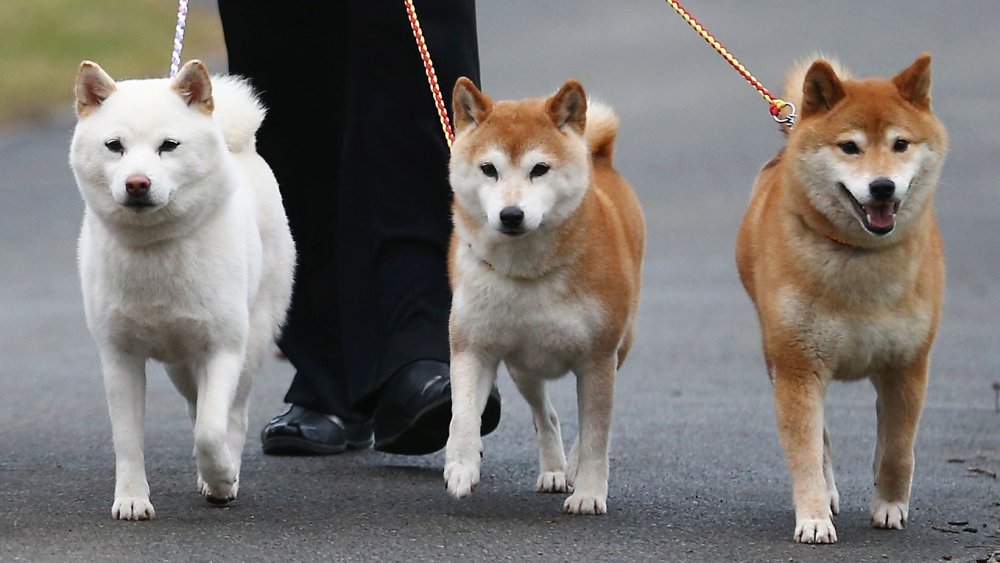The Dog Breed That Is Closest To A Fox
There's an old saying that says you can't run with the fox and hunt with the hounds. But what if a hound looks just like a fox? You and Elvis might say it still ain't nothin' but a hound dog and it ain't no best friend of yours, but your eyes may not realize that it's a hound in sheep's clothing ... Wait no, a foxy sheepdog. Maybe an undercover German Shepherd? Whatever. Metaphors are hard.
The point is that canines are liars. In some cases a domestic dog breed acts like a cat. Another type of dog might look or act like a wolf. And an especially sly dog might be mistaken for a sly fox. But which doggie dissembler comes closest to running with the fox?
The faux fox
Before digging into the nitty-gritty, it makes sense to emphasize what makes dogs different from foxes in the first place. Rover notes that while foxes and dogs share a family tree, their respective evolutionary roots branch in drastically different directions. Dogs belong to the genus canis while foxes predominantly belong to the genus vulpes plus several other kinds of non-canis. Since vulpes accounts for the "12 most common 'true fox species'", that will be the focus for foxes.
Foxes generally have smaller frames, flatter skulls, and shorter life spans than most dogs. Whereas your average furry best friend might live 10 to 13 years (if not longer), a typical fox in the wild kicks the bucket after two to four years. Because foxes are wild, they're not especially sociable. They aren't just sly but also shy and remarkably hard to train, which probably means they will pee all over your house. Fox importer Kay Fedewa told Popular Science that the scent of fox urine is like "cat pee, but a million times worse. It smells like skunk; it's the most pungent thing in the universe." If you've ever taken a whiff of a dog's pee, ew, but also, that's a significant difference.
With those distinctions in mind, which domestic dog is the foxiest? The Spruce Pets lists 10 candidates. The leader of the pack is probably the Shiba Inu, which looks like a fluffy red fox. This Japanese breed has a diminutive frame, is hard to train, and can be prone to aggression. However, The Spruce Pets didn't specify whether its pee smells unbearable.
Teaching an old doge new clicks
If you know your memes, then you may associate Shiba Inus with the Doge, the fox-faced cutie that wooed the internet in 2013. Know Your Meme explains that the web's best friend was adopted by Japanese kindergarten teacher Atsuko Sato in 2008. The now iconic photo of her wide-eyed Shiba Inu, Kabosu, was originally posted in 2010. The use of "doge" in reference to dogs goes back even farther, emerging as early as 2005. Know what's even older than that? The Shiba Inu breed, which existed centuries before "doges" ascended to Internet superstardom.
Per PetMD, the Shiba Inu likely functioned as a hunting dog in central Japan circa 300 B.C. Its specific lineage is unclear, but the breed belongs to a category of canines known as "spitz." According to the American Kennel Club, roughly 50 to 70 different breeds of spitz exist. Despite that diversity, there are certain commonalities, such as "pointy, pricked ears; almond-shaped eyes; a heavy, double coat; and a feathery tail carried over the back." These features create a "wolf-like appearance" — or in the case of the Shiba Inu, more of a foxy one.
Letting the dogs of war slip through the cracks
The American Kennel Club writes that the first recorded instance of a Shiba Inu in the United States dates back to 1954. That particular dog was introduced to the U.S. by a military family. That's rather fitting, considering that this breed had the fight of its collective life during WWII and the 1950s. PetMD says the ravages of war nearly annihilated the breed altogether, and that was just the beginning of its struggles. In the 1950s, the already weakened breed had to battle distemper, which the AKC describes as "one of the most serious diseases your dog can get."
Dangerous, contagious, and currently incurable, distemper attacks the respiratory tract via the lymphatic system and then expands its assault, eventually spreading to the brain and eyes. If a canine sufferer is lucky, (which depends on health, the strain of distemper, etc.), the symptoms will subside after 10 days. For the less fortunate, it's lethal. Luckily, the battle-tested Shiba Inu was tough enough to take distemper's best shot.



